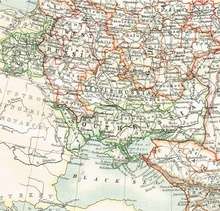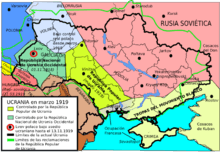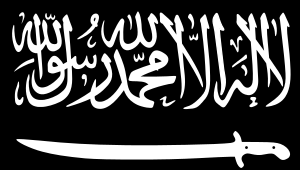Southern Russia
.svg.png)
Southern Russia or the South of Russia (Russian: Юг России, Yug Rossii) is a colloquial term for the southernmost geographic portion of European Russia, generally covering the Southern Federal District and the North Caucasian Federal District.[1] During World War I, the south had a large Russian population, Muslim minorities, and other non-Russians.
The term does not conform to any official areas of the Russian Federation as designated by the Russian Classification on Objects of Administrative Division (OKATO).
In Soviet historiography, southern Russia also was referred to as "White South" (Russian: Белый Юг, Byelii Yug) in reference to the White Army that fought the Bolsheviks along with the Armed Forces of South Russia and the Volunteer Army. It was never a formal subdivision, neither did it have strict boundaries.[2]
History



Russian Civil War until the Great Patriotic War
During the Russian Civil War (1917–1922), a territory called South Russia briefly existed after World War I from 1919–1920, which spanned the southern parts of the Russian Empire and included large portions of Ukraine.
On June 23, 1917, Ukraine was officially recognized as an independent country.[lower-alpha 1] By late 1918, independent Ukraine, freed from Russian domination and with Austrian-German support, expanded its recognized borders eastward to include southern Russia: Crimea,[lower-alpha 2] Kuban, and the Cossack lands of the Don and Terek. South Russia also contained a very large population of Ukrainians during World War I.
In April 1917, the Kuban Cossacks with Nakazny Ataman proclaimed the Kuban Rada as the supreme administration of the Kuban. On September 24, 1917, the Kuban Rada formed the Kuban legislature, and, after the Bolsheviks or Reds captured power in Petrograd, the Kuban People's Republic was formed on January 28, 1918 with its capital in Yekaterinodar. The Kuban Rada declared its independence on February 16 and sought union with the officially recognized independent Ukrainian Peoples Republic. The Kuban People's Republic included all territory of the former Kuban Oblast.
In April 1918, the Don Army was formed.[lower-alpha 3] After failing to oust the Bolsheviks from Petrograd during the Kerensky–Krasnov uprising, Pyotr Krasnov[lower-alpha 4] arrived in the south and, in May 1918, became the Don Cossack Host Ataman at Novochercassk. Supported by Germany, he equipped the army that removed the Soviets from the Don region in May–June 1918. By the middle of June, a Don Army was in the field with 40,000 men, 56 guns and 179 machine-guns. Later, in the second half of 1918 with his flanks in the south protected by the Whites[lower-alpha 5] and an independent Ukraine which was under substantial Austrian-German support and included the Kuban and the Don Cossacks and the Terek Cossacks lands, Krasnov advanced towards Povorino-Kamyshin-Tsaritsyn, intending to march on Moscow, but was defeated.

In November 1917, the Don region of southern Russia revolted against Lenin's rule and formed the Volunteer Army on November 17, 1917,[lower-alpha 6] in Novocherkassk of many Don Cossacks and Whites under the Tsarist Generals Mikhail Alekseyev, Alexander Lukomsky, Sergey Markov, Anton Denikin, and commanded by Lavr Kornilov; all of whom had fled to the south in 1917. In February 1918, the Reds captured Taganrog. Later, with the Reds capturing Rostov-on-Don, the Volunteer Army, searching for its bluebird from February to April, recruited troops south of Novocherkassk from the Kuban during its Ice March. On April 10, during the Volunteer Army's assault on Ekaterinodar, which was the Reds capital of the recently established North Caucasian Soviet Republic,[lower-alpha 7] Kornilov, leader of the Volunteer Army, was killed when an artillery shell destroyed the farmhouse where he had set up headquarters. Denikin succeeded him in command and abandoned the assault withdrawing back northward toward Rostov and eventually to Novochercassk. Arriving on April 24, 1918, from his 900-mile Iassy-Don March, Colonel Mikhail Drozdovsky defeated the Reds at Novocherkassk and joined his forces with the Volunteer Army. Major General Drozdovsky,[lower-alpha 8] who marched his elite White Volunteer Army unit, the 3rd Infantry Division, across the whole of Novorossiya to the River Don, defeated Makhno's Anarchist Black Army forces[lower-alpha 9] thereby placing the south in the hands of the Whites.
Altogether, these units on January 8, 1919, constituted the Armed Forces of South Russia.
With the end of World War I, independent Ukraine lost support from the Central Powers causing a power vacuum in the former Russian Empire's south.[lower-alpha 10] In November 1918, Krasnov lost German support. In January 1919, he acknowledged Denikin as supreme commander of the White Armed Forces of Southern Russia and, subsequently, on February 19, 1919, fled to western Europe in exile.
Also, beginning in December 1917, Felix Dzerzhinsky, head of the Cheka, had very strong support to violently suppress persons opposed to Bolshevism. He instituted the Red Terror and decossackization to exterminate anyone who would counter the Communist Revolution which had placed the Reds or Bolsheviks at the head the government. Whites opposed the Reds and southern Russia fiercely supported the Whites. Additionally, the ruthless brutality and atrocities of the Red Terror caused many Russians in the upper Don as well as Russians in the south to join the Whites, the Blacks, and others in opposition to the Reds.
In early 1919, Anton Denikin, as commander of the Armed Forces of South Russia marched on Moscow. On January 23, 1919 the Volunteer Army under Denikin oversaw the defeat of the 11th Soviet Army and then captured the North Caucasus region. After capturing the Donbass, Tsaritsyn and Kharkov in June, Denikin's forces surrounded Moscow on July 3, 1919 (N.S.). It appeared that his Whites would succeed in ousting the Reds from power. However, Leon Trotsky, as the supreme commander of the Red Army, hastily concluded an agreement for Makhno's anarchist Black Army to head east and attack Denikin's extended lines of supply which forced the Whites to retreat. Denikin's army would be decisively defeated at Orel in October 1919, some 400 km south of Moscow.
In October 1919, the Red Army invaded independent Ukraine splitting the anti bolshevik Ukrainian forces from the Whites in southern Russia.

In February 1920, the South Russian Government was established with Denikin in charge in Novorossiysk. With the Reds victories in the Kuban, the remnants of the Volunteer Army were evacuated on March 26 and 27, 1920, from Novorossiysk to the Crimea and merged with Wrangel's Army. The South Russian Government was dissolved on 30 March in Feodosiya.
The Government of South Russia was established at Sevastopol, Crimea, in April 1920 with General Pyotr Wrangel elected new Commander-in-Chief of the White Army by military council. This was the first attempt at a civilian government for the Whites in the south.[lower-alpha 11] It governed Crimea and adjacent territories similar to the former Taurida Governorate. France officially recognized it in August 1920. However, further international support was lacking allowing the Reds to advance. On November 16, 1920, the last remnants of the White forces were evacuated to Constantinople with over 146,000 White supporters evacuated during November 1920.
In December 1922, the Soviet Union was formed, but the south was fiercely anti Bolshevist. As punishment for southern Russia's staunch stand against the Communist forces, the Cheka, not only performed genocide under the Red Terror and the Holodomor against Ukrainians, Tartars, Cossacks, and others, but also deported many to the concentration camps, GULAGs, in the Arctic and in Siberia. This greatly reduced the population of non-Russians and anti Bolshevist Russians in the south by many millions during the Soviet years before World War II.
General area



Historically, where is Southern Russia?
There are no strict boundaries for Southern Russia.
Historically, one must remember that the Russian Empire was centered on Ivan the Great's city of Moscow.[lower-alpha 12] Also, Russians think of Russia's expansion routes or even Russian security or the invasion routes into Russia. So, a Russian's sense of where are things located within or nearby Russia are from the perspective of taking a train ride from Moscow.
- Northern Russia (Arkhangelsk, Murmansk): the way to the Arctic
- Northwestern Russia (St Petersberg, Finland, Karelia, Estonia, Latvia, Lithuania): eastern shoreline of the Baltic Sea; the invasion route from Sweden
- Western Russia (Belarus): the invasion route from Poland, France, and Germany
- Southwestern Russia (western Ukraine): the invasion route from the Balkans and Austria
- Central Asian Russia (Kazakhstan, Kyrgyzstan, Turkmenistan, Tajikistan, Uzbekistan): from the eastern shore of the Caspian Sea to China; the way to India
- Eastern Russia (Urals, Siberia, and the Far East): the way to Mongolia, China, and the Pacific Ocean
- Southern Russia (Ukraine, the Caucasus, Georgia, Armenia, Azerbaijan): the invasion route from Turkey and Persia in the Near East
So, Southern Russia is between the route to the Balkans and the route to central Asia. Southern Russia is along the Black Sea. During the Russian Empire, southern Russia is central and eastern Ukraine, as well as Crimea, the Don and the Sea of Azov. Southern Russia is the Caucasus. Southern Russia is the land of the Cossacks. Southern Russia is along the western shore of the Caspian Sea. Southern Russia is the lower Volga and west of the Volga. Sometimes, even Saratov is southern Russia, but not always. Southern Russia are not only Russians but also Ukrainians, Tartars, Greeks who speak Pontic Greek, Cossacks, the peoples of the Caucasus (many of which are Muslims), Georgians, Armenians, Azeris, and Germans whom Catherine the Great encouraged to settle in Russia as farmers of the black soil.
Southern Russia is dark or black (Russian: черный, chornyy):
- Black Soil: the soil (Russian: чернозем, chornozem)[lower-alpha 13]
- Black Sea the sea (Russian: Черное море, Chernoye more)
- Black Army: the army of Nestor Makhno, a leader of the anarchist political movement which was popular in southern Russia during the Russian Civil War. Makhno's Black Army was not Islamist.
- Black Flag: the standard of an anarchist often seen during the Russian Civil War, or, presently, an Islamist standard[lower-alpha 14]
- Black Person: the people, but not an African race (Russian: чёрный человек, chorniy chelovek) Often, the peoples of southern Russia have a swarthy complexion with dark eyes and black hair.[lower-alpha 15]
Since the collapse of the Soviet Union
Since the dissolution of the Soviet Union in 1991 with Ukraine, Georgia, Armenia, and Azerbaijan no longer a part of Russia, the area of Southern Russia approximately spans two of the nine federal districts of Russia, which contain a combined 13 federal subjects:
In relation to the official economic regions of Russia, most of Southern Russia is included in the North Caucasus economic region, with the exception of the Astrakhan Oblast, the Republic of Kalmykia and the Volgograd Oblast, which are part of the Volga economic region.
Usage
References to "Southern Russia" can be found in media or news portals devoted to the area. Newspapers and websites like Rossiyskaya Gazeta and Vedomosti have sections or tags for the area.[4][5]
See also
Notes
- ↑ Russia officially recognized Ukraine's independence on March 3, 1918, after the signing of the Treaty of Brest-Litovsk.
- ↑ In 1954, Crimea was officially added to Ukraine.
- ↑ The Don Cossacks had tried to organize an army earlier in 1918, but were unsuccessful. With the Red Terror instituted on the Don Cossacks in the spring 1918, the Don Cossacks gained much more fortitude to raise an army against the notorious Red menace.
- ↑ Krasnov was imprisoned and later released provided he did not participate against Bolshevist rule.
- ↑ The Reds and the Blacks were not active along his army's supply lines in Southern Russia because of crucial support from the Whites.
- ↑ The formation of the Volunteer Army was announced on January 9, 1918.
- ↑ Created by merging the Kuban-Black Sea Soviet Republic, the Stavropol Soviet Republic, and the Terek Soviet Republic, the North Caucasian Soviet Republic was a short lived (collapsed in December 1918) Bolshevist attempt to control the south. On August 17, 1918, Ekaterinodar was taken by Denikin's Volunteer Army, and the capital was moved to Pyatigorsk which was captured in December 1918, thus ending an official Reds government in the south.
- ↑ He was wounded in October 1918, during a battle near Stavropol. Although initially it was thought that the wound was not serious, he never recovered and died on January 1, 1919, in the vicinity of Rostov-on-Don.
- ↑ In addition to support in the Free Territory, anarchists had very strong support from Russians around the coal mines of the Donbass.
- ↑ In 1917-1921, Russia was a rump state within the former Russian Empire. The Soviet Union was not formed until later in December 1922.
- ↑ Both the impending collapse of independent Ukraine's final civilian government, which occurred in November 1920, and the official recognition by France in August 1920 of South Russia's independence precipitated the establishment of a civilian government for South Russia.
- ↑ Under Ivan the Great, Moscow emerged as the most dominate city state among Novgorod, Pskov, Tver, and the Golden Ring in the Zalesye or Opolye.
- ↑ However, the Russian black soil region extends beyond southern Russia.
- ↑ During the 1990's to present, the Caucasus Jihadists or the Caucasus Islamic State use a black standard for their symbolism as well as their color of choice.
- ↑ Sometimes, Russians think that a chorniy chelovek (Russian: чёрный человек) is an "evil person" as well as a "person dressed in black".
External links
- Спектр (Spectrum), news portal
- ЯСНО (Clearly), news portal
- Southru.ino, news portal
References
- ↑ Yevgeny Popov (9 December 2012). "Кто подрывает юг России" [Who Controls Southern Russia?]. Russia-1 (in Russian). Retrieved 30 January 2015.
- ↑ Ушаков, А. И.; Федюк, В. П. (1997). Белый Юг. Ноябрь 1919 — ноябрь 1920. Москва: АИРО-XX. ISBN 5-88735-045-8.
- ↑ Markoff, Dr. Alexandr Pavlovich (1933). professors of the Russian Commercial Institute, eds. "Famine in the USSR" (pdf). Bulletin Economique Russe (in French). 91, Rue Lecourbe, 91; Paris 15e, France: English translation by the Russian Commercial Institute in Paris. 9. Retrieved April 18, 2016.
- ↑ "Юг России" [Southern Russia]. Rossiyskaya Gazeta (in Russian). Retrieved 30 January 2015.
- ↑ "Юг России" [Southern Russia]. Vedomosti (in Russian). Retrieved 30 January 2015.
Coordinates: 45°24′00″N 43°00′00″E / 45.4000°N 43.0000°E
